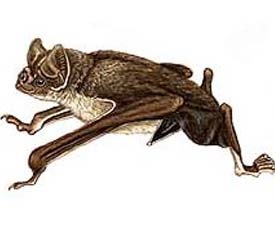Common vampire bat
Desmodus rotundus

SIZE: body=8 cm; weight=30 g
DESCRIPTION: Moderately large greyish brown bat with short glossy fur. Front upper teeth are very sharp and blade-like. Thumbs are long and very well-developed.
ACTIVITY: Agile flier, leaves roost well after dark
HABITS: Obligate blood feeder. Preys on domesticated and wild mammals. Usually lands on the ground and approaches animal on thumbs and feet. Can leap up onto prey in a single bound. Cuts a bit of flesh with its sharp teeth and an anticoagulant in the vampire’s saliva allows it to lap up the blood that is pooling on the wound. Roosts in hollow trees and caves. Stable female groups of 8 to 12 are formed with males competing for access. Their complex social structure includes regurgitating blood meals to those that have not fed.
HABITAT: Primary forest (where their densities seem naturally low), but they are more numerous near farmland.
STATUS:Often common. IUCN lists this bat as a species of least concern.
The blue “Q” icon above will change into a playable Quicktime video if your computer allows such media content. Be patient – it may take a moment to load, and you may need to approve a browser alert about this media type.